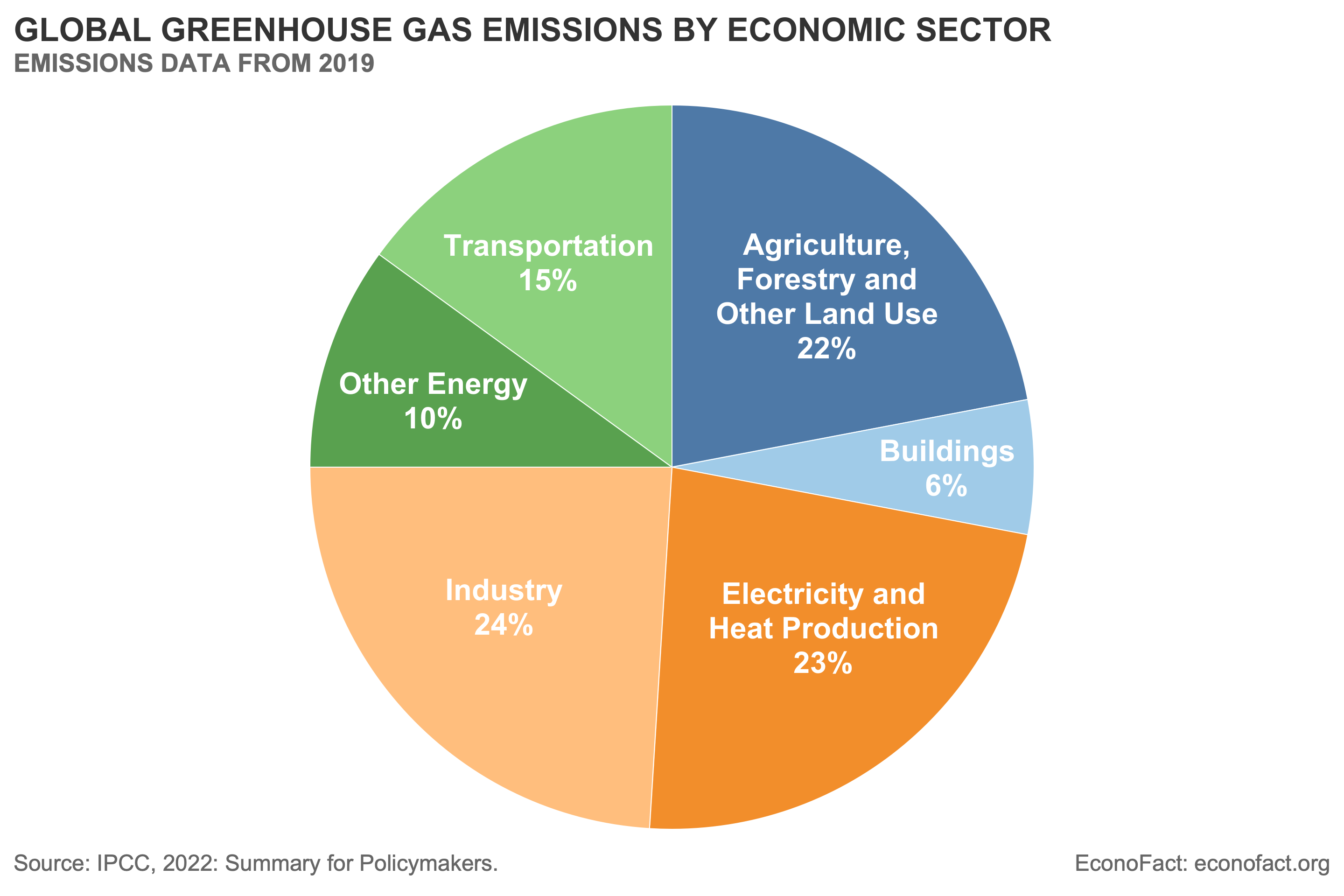The Importance of the Food Industry for Climate Change | Econofact
The Importance of the Food Industry for Climate Change Econofact


Climate Change
·September 12, 2023
The Issue:
The effects of climate change are becoming more apparent in the increasing frequency of heat waves, floods, hurricanes, and wildfires worldwide. Yet climate action is still lagging behind the Paris climate goals of keeping the average global temperature increase below 1.5 degrees C. Substantial gains have been made in emission-free energy generation and electric transportation and appliances, although they are still insufficient to keep us on track. Other indicators are actually heading in the wrong direction, chief among them is greenhouse gas emissions from agricultural production. This is partially due to the lack of information about the importance of the food sector in generating emissions. Greater policy attention on reducing emissions associated with food production opens an important avenue to limit global warming.
Agriculture is the largest source of anthropogenic methane emissions.
The Facts:
- Carbon dioxide (CO2) is the most important greenhouse gas and it is naturally the most discussed and targeted by policies. In 2020, CO2 contributed 73% to the total global greenhouse gas emissions. The use of fossil fuels is the primary source of carbon dioxide released into the atmosphere. In particular, the burning of coal, natural gas, and oil for electricity and heat has been the largest single source contributor of global greenhouse gas emissions, according to the Environmental Protection Agency. The three other main gas contributors to global greenhouse emissions are: methane (CH4), at 18% when converted to the CO2-equivalent greenhouse effect; nitrous oxide (N2O), also known as “laughing gas”, at 6.5%; and multiple Fluorinated gases (F-gases), like those from refrigeration, at 2.5% (author’s calculations based on Climate Watch data).
- Methane deserves special policy attention for a variety of reasons. Not only is methane the second most important gas when it comes to the share of greenhouse emissions, but some of its properties also make it an especially relevant gas to target. Global warming and climate change are the result of the concentration of greenhouse gases in the atmosphere. Thus, it is important to pay attention to how long each of the gases remains in the atmosphere as well as the flow of emissions. Methane deserves special attention in this respect, because of its relatively short life — estimated to be around 10 years, as opposed to over 100 years for CO2 and N2O. In addition, the warming impact of different greenhouse gases depends, in part, on their ability to absorb energy while in the atmosphere. Methane absorbs much more energy than carbon dioxide.
- Reducing methane emissions is the fastest way to affect the concentration of greenhouse gases in the atmosphere. Despite its relatively short life, the concentration of methane in the atmosphere has increased by more since 1950 than that of any other gas. Methane’s relative short life in the atmosphere, its greater ability to absorb energy and the fact that methane emissions have been increasing faster than other gases means that targeting the emissions of methane could lead to important gains in the short term. While methane converts to CO2 after about 10 years in the atmosphere, this still leads to overall reduction in greenhouse gas concentration when measured in CO2 equivalents because the greenhouse effect from methane is 25 times more potent than that of CO2.
- Agriculture is the largest source of methane emissions caused by human activities. In 2020, 42% of methane emissions came from agriculture, with livestock emissions (from manure and from the animals’ digestive process) and paddy rice cultivation accounting for 32% and 8% of agricultural methane respectively, according to a 2021 United Nations report. It is estimated that agriculture, including forestry and land use practices, is responsible for over 20% of emissions globally (see chart).
- In addition to methane emissions, agriculture contributes to climate change through nitrous oxide (N2O) emissions and by reducing carbon sequestration through deforestation. Agriculture is responsible for 75% of N2O emissions. Different management practices of agricultural soils — including fertilizer use; drainage and irrigation practices; the cultivation of nitrogen-fixing crops; management of manure; and the burning of agricultural residues — can increase the availability of nitrogen in the soil and result in N2O emissions (see here). Moreover, agriculture is the main source of deforestation, with forests being cleared to create cropland and pasture for subsistence farming as well as for large-scale production. The food industry is one of the most globalized industries, and much of deforestation is due to production of food for exports. For instance, deforestation in the Amazon in recent years is largely due to Brazil’s food exports to China and India. This matters because old-growth forests, especially the Amazon, are the best approach we have to carbon sequestration.
- Focusing on animal-sourced foods could yield high returns in combating climate change. Due to its inherent inefficiency, animal agriculture is responsible for most of agriculture’s greenhouse gas emissions, deforestation, water and land use. About 25 calories are required to create just 1 calorie of beef, 15 calories for 1 calorie of pork, and 9 calories for 1 calorie of chicken. Replacing animal-sourced foods with entirely plant-sourced versions has the potential to reduce or offset 68% of anthropogenic greenhouse gas emissions, according to a recent study. However, it is unreasonable to expect the global population to switch to 100% plant-based diets.
- Solutions to emissions from the food system are analogous to solutions to energy production and consist of two main pillars: more efficient use of resources and the technological development of alternatives. In the case of energy, more efficient use of resources means greater energy conservation, insulation, and energy-efficient appliances. In the case of food, it means an increase in crop yields, a reduction
SDGs, Targets, and Indicators
1. Which SDGs are addressed or connected to the issues highlighted in the article?
- SDG 13: Climate Action
- SDG 2: Zero Hunger
- SDG 15: Life on Land
2. What specific targets under those SDGs can be identified based on the article’s content?
- SDG 13.2: Integrate climate change measures into national policies, strategies, and planning.
- SDG 2.4: Ensure sustainable food production systems and implement resilient agricultural practices.
- SDG 15.2: Promote the implementation of sustainable management of all types of forests.
3. Are there any indicators mentioned or implied in the article that can be used to measure progress towards the identified targets?
- Greenhouse gas emissions from agricultural production can be used as an indicator to measure progress towards SDG 13.2 and SDG 2.4.
- The percentage of methane emissions from agriculture can be used as an indicator to measure progress towards SDG 13.2 and SDG 2.4.
- The percentage of N2O emissions from agriculture can be used as an indicator to measure progress towards SDG 13.2 and SDG 2.4.
- The extent of deforestation caused by agriculture can be used as an indicator to measure progress towards SDG 15.2.
SDGs, Targets, and Indicators
SDGs Targets Indicators SDG 13: Climate Action 13.2: Integrate climate change measures into national policies, strategies, and planning. – Greenhouse gas emissions from agricultural production
– Percentage of methane emissions from agriculture
– Percentage of N2O emissions from agricultureSDG 2: Zero Hunger 2.4: Ensure sustainable food production systems and implement resilient agricultural practices. – Greenhouse gas emissions from agricultural production
– Percentage of methane emissions from agriculture
– Percentage of N2O emissions from agricultureSDG 15: Life on Land 15.2: Promote the implementation of sustainable management of all types of forests. – Extent of deforestation caused by agriculture Behold! This splendid article springs forth from the wellspring of knowledge, shaped by a wondrous proprietary AI technology that delved into a vast ocean of data, illuminating the path towards the Sustainable Development Goals. Remember that all rights are reserved by SDG Investors LLC, empowering us to champion progress together.
Source: econofact.org

Join us, as fellow seekers of change, on a transformative journey at https://sdgtalks.ai/welcome, where you can become a member and actively contribute to shaping a brighter future.








